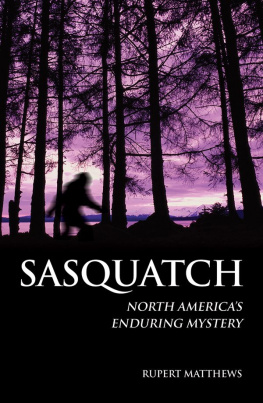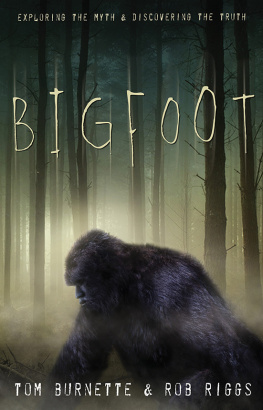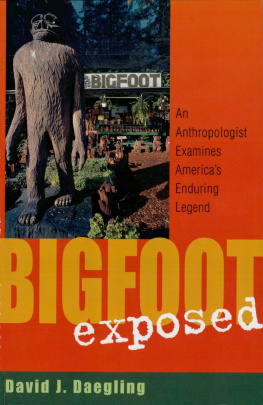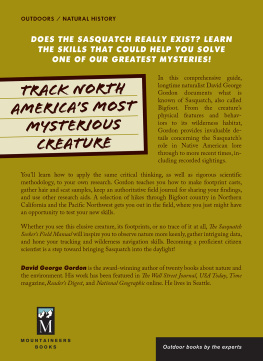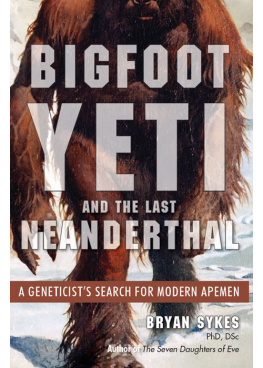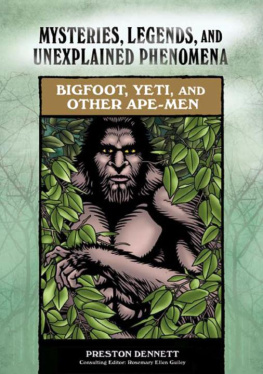FORGOTTEN BIGFOOTS
AROUND THE WORLD
by
Malcolm Smith
Forgotten Bigfoots around the world
Independently published 2020
Copyright Malcolm Smith, 2020
The translations in this book are copyright. Apart from fair dealing for the purposes of private study, research, criticism or review, as permitted under the Copyright Act, no part may be reproduced by any process without written permission. The copyright of the original language versions remain with the original authors.
- Cryptozoology 2. Bigfoot 3. Yeti 4. Almasty
- Almas 6. Caucasus
ISBN: 9798671311297
Cover illustration by Jordi Magraner, based on a witnesss testimony.
List of Chapters
Introduction
PART I. ASIA
- The Yeti of Pakistan
- The Creatures of the Caucasus
- The Mongolian Wild Mans Last Stand
- What Are They?
PART II. EUROPE
- The Wild Man of the Pyrenees
- The Barcelona Satyr
PART III. LATIN AMERICA
- Honduras: Encounter in a Dark Hut
- Ape Attack in Guatemala
- Bigfoot in the Andes
PART IV. AFRICA
- Unknown African Pygmies?
- Tales from the Kenyan Woods
- Two Unknown Bipedal Apes in the Congo
Other Books by the Author
INTRODUCTION
No doubt all of you have heard of the Yeti or Abominable Snowman of the Himalayas, and the Bigfoot or Sasquatch of North America. But as far back as1961, with the publication of Abominable Snowmen:Legend Come to Life , Ivan T. Sanderson alerted us to the fact that legends and reports of similar creatures exist all over the world. (Well, not exactly all over; even he was unaware of the yowie, the Australian version of the group.)
Comparing the reports, it is clear that they do not all refer to the same species, but all of them are primates ie ape-like creatures which, unlike the known apes, are bipedal. While the existence of such a creature could remain unknown to science in the remote fastness of the Himalayas, it would appear fantastic to most of us that the same could occur in such a worked-over area as North America. Nevertheless, they all possess certain characteristics which might facilitate it.
First of all, unlike other apes and monkeys, they are nocturnal. Many have, of course, been sighted during the day, but it is at night that they are mostly active. Certainly, most of the encounters close to human habitation have occurred at night. Secondly, they are solitary. An extended family of gorillas would hardly be missed by the local human representatives, but one or two gorillas wandering the forest at night might be a different matter. Thirdly, they are shy of humans almost to the point of phobia.
Finally, because they do not officially exist, people who claim to have seen them are not believed. Scientists do not go out looking for them because they do not officially exist. Most zoologists would not even come out to check of a trail of footprints if it were reported to them. If any zoologist did, and wrote a report on his finding, the odds are that no peer reviewed journal would publish it, and the zoologist himself would become a laughing stock among his colleagues. In short, once an animal has somehow avoided being added to the list of discovered species, that very fact will work to make its unknown status permanent.
Not only that, but such mystery animals tend to receive whimsical labels by journalists who only half believe in them. Thus, although there is no logical reason why a large, unknown primate might not exist in the little explored regions of the Himalayas, what scientist could take seriously a snowman, especially an abominable one? To do so would be to commit the cardinal scientific sin of jumping on to the bandwagon of the uneducated masses.
Nevertheless, although such matters fail to get raised at official zoological conferences, they not uncommonly form the subject of informal discussions when zoologists meet around the table. The investigation of such animals is known as cryptozoology, from the Greek cryptos , meaning hidden, and the animals themselves are called cryptids.
It is not my intention to cover the whole worldwide field of mystery bipedal apes, or ABSMs (abominable snowmen) as Sanderson labelled them. That would require a volume far thicker than this. Rather, it is to introduce to the English speaking public important articles originally published in French or Spanish, with a couple of obscure English ones thrown in for good measure.
If sometimes my translation appears a little stiff, this is because I have favoured accuracy over elegance. Just the same, I do not claim to be a professional translator, as much at home in the foreign as in my own. On the contrary, I freely admit that, at times, I have run up against phrases which are far from clear, and words which do not appear in any available dictionary. Nevertheless, I am confident that the overall purport of the text has been made clear. Considering all the uncertainty involved in cryptozoology, questions about the precise meaning of a foreign term are low on the list of problems.
My translations have been bracketed with introductions and commentaries, but I have ensured that these are always printed in the San Serif font you are now reading, which is quite different to the font used in the actual translations. You should therefore have no problem distinguishing whether I am speaking on my own bat, or channelling an author.
Naturally, an issue arises about copyright. The translations, of course, are mine, but the copyright for the original articles remains with the original authors, most of whom are impossible to contact, and some of whom are dead. Nevertheless, the originals came most from non-commercial journals, many of which were obscure even in their own countries. I am reasonably certain that no-one has been disadvantaged by my translation, but if anyone feels they have been, they are welcome to contact me.
Finally, I wish to thank Michel Raynal for forwarding some of the articles to me.
PART I
ASIA
Asia is a big continent, so you should not be surprised to learn that mystery primates (ABSMs)are rumoured to exist in more than one area.
Such is the yrn , or wild man of China, particularly Hubei province, which had been extensively investigated by a team under Prof. Zhou Guoxing of the the Beijing Museum of Natural History. It is only fair to add, however, that after more than thirty years of research, he reluctantly came to the conclusion that the evidence was bogus.
Indochinas ngi rng were labelled rock apes by the GIs who encountered them, but the Vietnamese name means simply man of the forest, the equivalent of the Malay orangutan.
The orang pendek , or short man, isolated in pockets of dense forest in Sumatra, has been the subject of numerous searches, and ranks as the ABSM most likely to be discovered soon, while footprints of perhaps a similar primate, the batutut , were discovered in Sabah by zoologist, John MacKinnon while researching wild orangutans. On the other hand, the orang dalam (interior man) of the Malay peninsula appears to be something huge.
However, these cryptids are not the subject of this section. Instead, I am concentrating on three areas: the Chitral region of Pakistan, the Caucasus mountains and, to a limited extent, Mongolia. (Yes, I know that the Caucasus is, strictly speaking, in Europe, but for reasons that will become obvious, their ABSMs are more relevant to Asia). The first two are covered by two lengthy dissertations, but in order to understand their point of view, it is necessary to know the background of a couple of important scholars.
The first was the Belgian-French zoologist, Dr. Bernard Heuvelmans (1916 - 2001), the father of cryptozoology. It was his book, On the Track of Unknown Animals , published in French in 1955 and in English in 1958, which essentially inspired the worldwide interest in mystery animals in general. In 1968 he was visiting the U.S. as the guest of Ivan Sanderson, of Abominable Snowmen fame, when they heard about the Minnesota Iceman.
Next page


